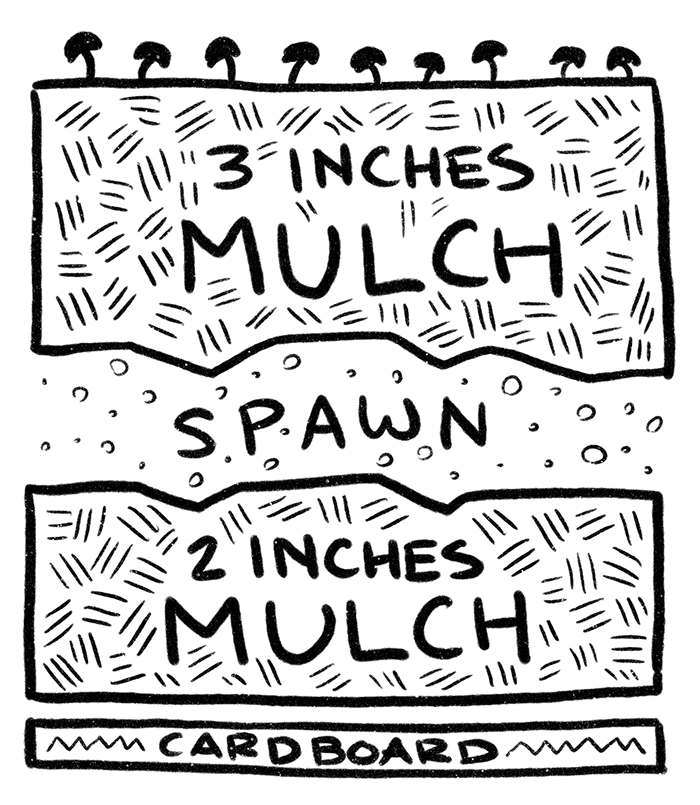If you like the idea of growing your own food and enjoy eating mushrooms, then you might be ready to cultivate fungi.
With a gardener’s attention, a little patience, and these tips, you can have delicious mushrooms right in your backyard or kitchen.
Indoor kits
 These are a block of mycelium, often living in sawdust or wood pulp, that is stored in a sealed plastic bag. If you think of the mushrooms that we eat as fruit, mycelium is the roots, stem, and leaves of the fungus. The kits come in different varieties of mushrooms, like shiitake or oyster, but there are general rules for taking care of the kits.
These are a block of mycelium, often living in sawdust or wood pulp, that is stored in a sealed plastic bag. If you think of the mushrooms that we eat as fruit, mycelium is the roots, stem, and leaves of the fungus. The kits come in different varieties of mushrooms, like shiitake or oyster, but there are general rules for taking care of the kits.
It’s best to think of the indoor kits as an annual edible plant because they produce quickly, but only for one season.
- Choose a spot you see often because an indoor mushroom kit needs regular care.
- Keep at 65–70°F, though the specific temperature will vary by variety, and in indirect sunlight.
- Leave your kit in its chosen spot until the block is completely white. At that point, the fungi have completely colonized it. (They could even be ready when you buy them.)
- Cut several slits in the bag: This is where mushrooms will fruit out of the main block. There are many different methods for this step, so see the specific instructions included with your kit or look online.
- 1 to 3 times a day, pour, sprinkle, or mist your block with non-chlorinated, non-distilled water. (Let tap water sit for 12–24 hours and it’s fine to use.) Mycelium like it moist, but not soaked.
- A few weeks after cutting the bag and starting to water, mushrooms should start sprouting!
Wine caps
 Wine caps are sold in blocks, sealed in 5.5-pound bags (somewhat like the indoor kits), but you grow them outside in wood mulch.
Wine caps are sold in blocks, sealed in 5.5-pound bags (somewhat like the indoor kits), but you grow them outside in wood mulch.
They’re great for adding food production to mulched walking paths in your vegetable garden or in any shady area where you can have wood chips. If you start a wine cap bed in spring, you will most likely get mushrooms the same fall, with bigger harvests the following summer.
- Start with a layer of cardboard on the bottom for weed suppression.
- Cover with 2” of non-dyed hardwood mulch. Wine caps like soft hardwoods the best (box elder, cottonwood, willow, soft maple, magnolia), but other hardwoods will work, too.
- Crumble up the wine cap mycelium block (“spawn”) and sprinkle over the top. A 5.5-pound bag plants 50 square feet.
- Add 3” or more of hardwood mulch on top. Water deeply right away. The top layer of mulch is thickest to protect the mycelium from drying out.
- Shallow beds work in shadier areas, with deeper beds needed in sunnier (drier) areas.
- Keep your wine cap bed moist, with about 1” of water per week.
- Wine cap beds can be maintained indefinitely if you continue “feeding” them with more mulch in future years as you notice your production declining.
- Straw mulch or a combination of wood and straw also work to grow wine caps, but the process is a bit different. Learn more at www.fieldforest.net or elsewhere online.
Outdoor logs
These are actual logs that have been injected, or inoculated, all over with small amounts of mycelium. Logs are much denser than sawdust, so the colonization step will take much longer, somewhere between 6 and 18 months depending on the variety. However, you will get mushrooms over a much longer period of time as the mycelium slowly decomposes the wood.
Depending on the size of your log, it could give you anywhere from two to five years of mushrooms. Here’s what to do:
- Keep your log outdoors in full shade, preferably in uncovered places so it can be rained and snowed on.
- Store the log upright on the ground or horizontally near — but not on — the ground, such as on a pallet.
- Try to keep the log consistently moist. 1” of rain per week is recommended, otherwise you will need to water it.
- Be patient. Wait for the first mushrooms towards the end of the colonization period. After your first natural mushroom, you can start force fruiting. Check out www.northwoodmushrooms.com to learn more about this optimal growing method.
- Log cultivation is a more advanced growing method than indoor kits or wine caps, with unique pros and cons. We recommend learning more on your own if you’re just starting out with mushroom logs.
There are lots of options when it comes to growing your own mushrooms. Hopefully this helps you figure out what kind of mushrooms are right for your garden!
—by A.J.